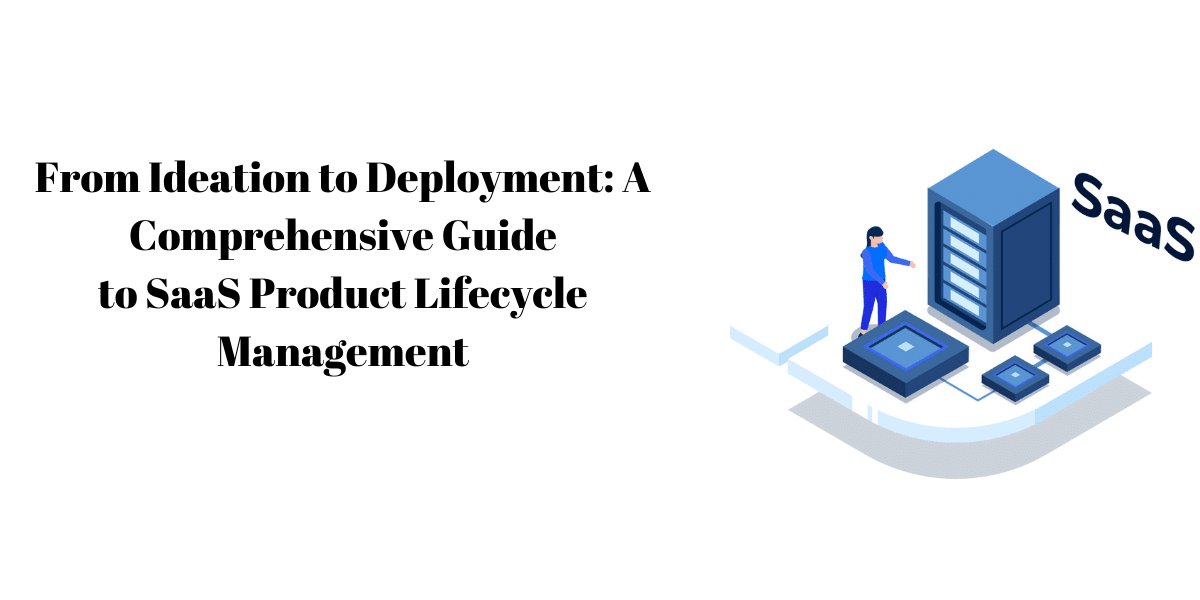In the ever-evolving landscape of technology, the development and deployment of Software as a Service (SaaS) products have become pivotal in meeting the dynamic needs of businesses and consumers alike. This comprehensive guide aims to illuminate the intricate journey from ideation to deployment, offering a roadmap for effective SaaS Product Lifecycle Management.
The ideation phase sets the stage for innovation, demanding a nuanced understanding of market dynamics and user requirements. As we delve into the subsequent stages, we explore the meticulous planning, agile development methodologies, and robust quality assurance processes that underpin successful SaaS products. From prototyping to user validation, this guide navigates through the intricacies of design and development, emphasizing the significance of scalability, security, and regulatory compliance.
With a focus on user experience, deployment strategies, and ongoing support, we unravel the multifaceted layers of SaaS product lifecycle, providing insights and strategies for creating and sustaining cutting-edge solutions in the competitive realm of SaaS software development.
Understanding Ideation in SaaS Development
Ideation is the foundational phase of Software as a Service (SaaS) development, serving as the creative nexus where innovative concepts take shape. In this critical stage, the emphasis is on understanding market dynamics, identifying user pain points, and envisioning solutions that transcend conventional paradigms. Successful ideation hinges on a comprehensive grasp of industry trends, emerging technologies, and an acute awareness of user needs. Market research plays a pivotal role, offering insights into competitor landscapes, potential gaps in existing solutions, and areas ripe for disruption.
The ideation process involves translating abstract ideas into viable concepts, assessing their feasibility, and aligning them with strategic business goals. It demands a delicate balance between innovation and practicality, ensuring that the envisioned SaaS product not only addresses current market demands but also possesses the scalability to adapt to future trends. Collaboration among cross-functional teams is instrumental during this phase, fostering a diversity of perspectives that enrich the ideation process. Prototyping and wireframing become invaluable tools, allowing stakeholders to visualize concepts and iterate on designs, facilitating a dynamic refinement of ideas.
User feedback becomes a crucial compass in navigating the ideation landscape, providing valuable insights into the viability and user acceptance of proposed solutions. This iterative process of refinement ensures that the eventual SaaS product aligns closely with user expectations and market demands. In essence, understanding ideation in SaaS development is about cultivating a creative environment where innovation is fueled by a deep comprehension of market dynamics, user needs, and the strategic vision that propels a product from conceptualization to fruition.
Defining the Core Concepts of Product Lifecycle in SaaS
Defining the core concepts of product lifecycle in Software as a Service (SaaS) is essential for orchestrating a seamless and successful journey from inception to obsolescence. The SaaS product lifecycle comprises several interlinked phases, each contributing to the overall development, deployment, and sustenance of the software solution. The initial stage involves ideation, where concepts are conceived, and market research is conducted to understand user needs and industry trends. Once the ideation phase is complete, planning becomes paramount, delineating the roadmap for development, resource allocation, and strategic milestones.
The development phase is characterized by coding, iterative design processes, and adherence to agile methodologies, ensuring adaptability and responsiveness to evolving requirements. Quality assurance and testing play a pivotal role in guaranteeing the robustness and reliability of the SaaS product, aiming to identify and rectify potential issues before deployment. The integration of scalability measures becomes crucial, anticipating and accommodating the product’s growth and increased demand.
Security considerations are woven throughout the SaaS product lifecycle, with a focus on safeguarding sensitive data and ensuring compliance with industry regulations. As the product nears deployment, comprehensive deployment planning is indispensable, encompassing strategies for a smooth transition from development to a live environment. Post-deployment, ongoing maintenance, user support, and continuous improvement initiatives come into play, refining and optimizing the product based on user feedback and evolving market conditions.
Finally, the product may reach its end-of-life phase, necessitating careful decommissioning and potential replacement with newer iterations or innovations. In essence, defining the core concepts of SaaS product lifecycle involves understanding the intricacies of ideation, planning, development, deployment, maintenance, and eventual obsolescence within a dynamic and ever-evolving technological landscape.
The Importance of Market Research in Ideation
The significance of market research in the ideation phase of Software as a Service (SaaS) development cannot be overstated, as it serves as the compass guiding the creation of solutions that resonate with user needs and align with market demands. Market research acts as the foundational cornerstone, providing crucial insights into industry trends, competitor landscapes, and potential gaps or unmet needs in the market. Through comprehensive analysis, developers and stakeholders gain a nuanced understanding of the dynamics shaping the industry, enabling them to make informed decisions during the ideation process.
In essence, market research acts as a bridge between abstract ideas and practical solutions, facilitating a strategic approach to product development. It allows teams to identify opportunities, assess potential risks, and validate the feasibility of proposed concepts. By delving into user demographics, preferences, and pain points, market research ensures that ideated solutions are not only innovative but also address tangible challenges faced by the target audience. Moreover, understanding market dynamics helps in setting realistic expectations, defining unique selling propositions, and positioning the SaaS product effectively within the competitive landscape.
Market research is an iterative process that evolves alongside changing market conditions, ensuring that the ideation phase remains dynamic and responsive. The insights gleaned from this research not only shape the initial concept but also inform subsequent stages of the product lifecycle, influencing planning, development, and deployment strategies. Ultimately, the importance of market research in ideation lies in its ability to provide a data-driven foundation for innovation, increasing the likelihood of creating a SaaS product that not only meets but exceeds user expectations in a competitive marketplace.
Navigating the Ideation Phase: From Concept to Feasibility
Navigating the ideation phase in Software as a Service (SaaS) development involves a strategic journey from conceptualization to feasibility, weaving together creativity, market insights, and pragmatic considerations. The ideation phase marks the inception of innovative concepts, where stakeholders explore potential solutions to address user needs and market gaps. It requires a creative and open-minded approach to generating ideas that can potentially disrupt or enhance existing paradigms within the industry. During this phase, cross-functional collaboration becomes integral, as diverse perspectives contribute to a richer pool of ideas and insights.
As concepts take shape, the transition from the abstract to the feasible becomes a pivotal step. This involves a careful evaluation of the technical, financial, and operational viability of the proposed ideas. Stakeholders must consider factors such as resource availability, technological feasibility, and alignment with organizational goals. Prototyping and wireframing emerge as valuable tools to visually represent concepts and facilitate a tangible understanding of their potential implementation.
The feasibility assessment is not only a gatekeeper to filter out impractical ideas but also a refining process, allowing the ideation team to iterate on concepts that exhibit promise. This iterative approach ensures that the selected ideas not only align with the overarching vision but also possess the potential for successful implementation and market acceptance. Ultimately, navigating the ideation phase from concept to feasibility demands a harmonious blend of creativity, collaboration, and strategic evaluation, setting the stage for the subsequent phases of SaaS development with a solid foundation of viable and innovative ideas.
Building a Solid Foundation: SaaS Product Planning
Building a solid foundation for Software as a Service (SaaS) products hinges on meticulous planning, a phase that follows the creative ideation process and lays the groundwork for successful development and deployment. SaaS product planning involves translating conceptual ideas into a structured roadmap, encompassing the entire lifecycle of the software. This phase is characterized by the delineation of clear objectives, setting achievable goals, and defining the scope of the project. It serves as the compass for decision-making, resource allocation, and strategic direction throughout the development process.
Strategic planning in the context of SaaS products extends beyond technical considerations, encompassing market dynamics, user requirements, and organizational capabilities. A robust business model is crafted, outlining revenue streams, pricing strategies, and avenues for scalability. This planning phase involves collaboration among cross-functional teams, ensuring that perspectives from marketing, development, finance, and other key areas are incorporated to create a comprehensive and cohesive plan.
Additionally, risk assessment and mitigation strategies are integral components of product planning. Anticipating potential challenges and devising contingency plans contribute to the resilience of the overall project. The planning phase also lays the foundation for an agile development process, allowing teams to adapt to evolving requirements and market conditions.
In essence, SaaS product planning is the compass that guides the development journey, providing a structured framework that aligns creative ideation with strategic objectives. A well-crafted plan not only facilitates efficient resource utilization but also enhances the likelihood of delivering a SaaS product that meets user needs, aligns with market trends, and is positioned for long-term success in a competitive landscape.
Crafting a Robust Business Model for SaaS Solutions
Crafting a robust business model for SaaS solutions is a pivotal step in ensuring the viability, sustainability, and success of a software product. Unlike traditional software models, SaaS business models necessitate a careful consideration of recurring revenue streams, scalability, and customer retention. The foundation of this process lies in defining the value proposition – understanding what unique benefits the SaaS solution brings to its users and how it addresses their pain points. The business model must then align with this value proposition to form a coherent strategy.
One of the key aspects of a SaaS business model is establishing pricing strategies. This involves determining the most effective way to monetize the service, whether through subscription-based models, tiered pricing, or usage-based pricing. The chosen model should be flexible enough to cater to different customer segments and adaptable to market dynamics.
Scalability is another critical element in crafting a robust business model for SaaS solutions. The model must accommodate growth by offering plans that align with varying customer needs, from individual users to large enterprises. Additionally, considerations such as infrastructure scalability and operational scalability are vital to support the increasing demand for the SaaS product.
Customer acquisition and retention strategies are integral components of the business model. Effective marketing, user onboarding processes, and customer support contribute to not only acquiring new customers but also retaining them over the long term. The goal is to create a recurring revenue stream while fostering customer satisfaction and loyalty.
In essence, crafting a robust business model for SaaS solutions involves a strategic alignment of value proposition, pricing, scalability, and customer engagement strategies. A well-defined and adaptable business model serves as the foundation for the sustainable growth of a SaaS product in a competitive market.
Prototyping and Wireframing: Visualizing SaaS Product Concepts
Prototyping and wireframing play pivotal roles in the SaaS product development lifecycle by serving as instrumental tools for visualizing and refining conceptual ideas into tangible, user-friendly interfaces. Prototyping involves creating interactive, functional models that simulate the user experience, providing stakeholders with a hands-on preview of the final product. This process not only helps in clarifying design concepts but also enables early-stage testing and validation of user interactions, ensuring alignment with user expectations.
Wireframing, on the other hand, is the skeletal framework of the user interface, focusing on layout, structure, and navigation. It serves as the blueprint that outlines the spatial arrangement of elements within the application. By emphasizing simplicity and functionality, wireframes provide a clear visual representation of the product’s information architecture and user flow, facilitating efficient communication between designers, developers, and stakeholders.
Together, prototyping and wireframing expedite the design iteration process. Stakeholders can provide timely feedback, and design teams can make necessary adjustments before moving into the more resource-intensive phases of development. This iterative approach not only enhances collaboration but also ensures that the final product aligns closely with the envisioned user experience.
Moreover, these visual tools are instrumental in communicating the design vision to non-technical stakeholders, facilitating a shared understanding of the product’s look and feel. This alignment is crucial for obtaining buy-in and support at various stages of development.
In summary, prototyping and wireframing are indispensable components of SaaS product development, enabling effective visualization, validation, and refinement of concepts to create user-centric and aesthetically pleasing software interfaces.
Iterative Design Processes in SaaS Development
Iterative design processes form the backbone of successful Software as a Service (SaaS) development, representing a dynamic approach where continuous refinement and improvement occur throughout the entire product lifecycle. Embracing iteration acknowledges that user needs, market dynamics, and technological landscapes evolve, requiring a flexible and responsive design methodology. This iterative cycle begins with the ideation phase and extends through development, testing, and even post-deployment phases.
The iterative design process involves creating prototypes or minimal viable products (MVPs) and gathering user feedback early and often. This feedback loop is instrumental in identifying potential improvements, addressing usability issues, and ensuring that the product aligns with evolving user expectations. Each iteration serves as a learning opportunity, allowing development teams to adapt and refine their approach based on real-world usage and feedback.
Furthermore, iterative design mitigates risks by uncovering and addressing challenges incrementally, reducing the likelihood of major setbacks later in the development process. This approach also aligns closely with agile development methodologies, fostering collaboration among cross-functional teams and emphasizing adaptability in response to changing requirements.
Iterative design processes extend beyond the development phase to encompass continuous improvement post-deployment. Monitoring user behavior, analyzing performance metrics, and staying attuned to market trends allow for ongoing refinement, ensuring that the SaaS product remains relevant and competitive in a rapidly changing landscape.
In essence, embracing iterative design in SaaS development is a strategic commitment to flexibility, user-centricity, and continuous enhancement. It enables development teams to deliver products that not only meet current requirements but also evolve seamlessly in response to emerging needs and industry shifts.
User Feedback and Validation in the Ideation Stage
User feedback and validation are integral components of the ideation stage in Software as a Service (SaaS) development, playing a crucial role in shaping concepts and ensuring that proposed solutions align with user needs. In this early phase, gathering insights from potential users is not just a validation step but a proactive measure to integrate the user perspective into the very foundation of the product. Engaging with the target audience through surveys, interviews, or prototype testing facilitates a deeper understanding of their preferences, pain points, and expectations.
User feedback serves as a valuable compass, guiding the refinement of ideas and features based on real-world insights. Early validation minimizes the risk of investing resources in concepts that may not resonate with the intended audience. It helps in fine-tuning the product concept, adjusting functionalities, and aligning the development trajectory with the identified user preferences.
Moreover, involving users in the ideation stage fosters a sense of ownership and engagement. It creates a collaborative environment where end-users feel heard and valued, contributing to the creation of a product that genuinely addresses their needs. This iterative process of collecting feedback, refining concepts, and validating ideas ensures that the eventual SaaS product is not only innovative but also practical and user-friendly.
In summary, user feedback and validation in the ideation stage serve as a cornerstone for user-centric design, enhancing the likelihood of creating a SaaS product that resonates with its intended audience and addresses genuine market needs. This iterative engagement with users lays the groundwork for a successful and user-friendly product development journey.
Transitioning from Ideation to Development: Key Considerations
Transitioning from ideation to development in Software as a Service (SaaS) encompasses a critical phase where strategic considerations play a pivotal role in shaping the trajectory of the product. One key consideration is the effective translation of conceptual ideas into actionable development plans. This involves refining and prioritizing features based on the feedback received during the ideation stage, ensuring that the development process aligns closely with the identified user needs and market demands.
The selection of an appropriate development methodology is another crucial consideration. Agile methodologies, characterized by flexibility and iterative cycles, are often favored in SaaS development. Agile enables adaptive planning, continuous improvement, and close collaboration among cross-functional teams, fostering a responsive and dynamic development environment. Establishing a clear roadmap, setting realistic timelines, and allocating resources judiciously are vital components of the transition phase, ensuring that development progresses smoothly and efficiently.
Moreover, integration of scalability considerations is imperative during this transition. Anticipating future growth and potential changes in user demands, the development process should be designed to accommodate expansion without compromising performance or user experience. This forward-thinking approach mitigates challenges associated with scaling the product as it gains traction in the market.
Effective communication and collaboration between various stakeholders, including developers, designers, and product managers, are paramount during this transition. A shared understanding of goals, timelines, and expectations helps streamline the development process and align efforts toward a common vision.
In essence, transitioning from ideation to development involves a meticulous orchestration of strategic planning, methodological choices, scalability considerations, and effective collaboration. A well-executed transition sets the stage for a smooth and successful development journey, ensuring that the envisioned SaaS product becomes a reality that meets both user expectations and market demands.
The Role of Agile Methodology in SaaS Development
The role of Agile methodology in Software as a Service (SaaS) development is pivotal, representing a dynamic and iterative approach that aligns seamlessly with the ever-evolving nature of the industry. Agile methodologies, such as Scrum or Kanban, prioritize flexibility, adaptability, and collaboration, making them well-suited for the iterative cycles inherent in SaaS development. One of the core tenets of Agile is the emphasis on delivering incremental value through short development cycles known as sprints, typically lasting two to four weeks. This iterative process allows for continuous feedback, enabling development teams to respond swiftly to changing requirements and integrate user insights into the evolving product.
The collaborative nature of Agile methodologies fosters cross-functional teamwork, ensuring constant communication and alignment among developers, designers, and other stakeholders. Regular sprint reviews and retrospectives provide opportunities for reflection and improvement, enhancing the overall efficiency of the development process. Additionally, Agile methodologies promote transparency and client involvement, with clients often engaged throughout the development lifecycle, fostering a sense of ownership and alignment with project goals.
Agile’s adaptability is particularly beneficial in the fast-paced SaaS landscape, where market dynamics, user preferences, and technological advancements can change rapidly. By breaking down the development process into manageable increments, Agile enables development teams to pivot, adjust priorities, and deliver value in response to emerging trends or shifting business priorities. Overall, the role of Agile methodology in SaaS development lies in its ability to provide a responsive and collaborative framework that aligns with the iterative nature of product evolution, ultimately contributing to the creation of robust, user-centric, and market-responsive SaaS solutions.
Coding and Development: Bringing Ideas to Life
Coding and development form the transformative phase in Software as a Service (SaaS) product creation, where conceptualized ideas begin to take tangible shape. This crucial stage involves translating design concepts, user stories, and system architecture into functional code, breathing life into the envisioned product. The coding process is characterized by the selection of appropriate programming languages, frameworks, and technologies that align with the project’s requirements and goals. Developers collaborate closely, adhering to coding standards, best practices, and often leveraging version control systems to maintain a cohesive and collaborative coding environment.
The development phase in SaaS is often guided by the principles of agile methodologies, emphasizing iterative cycles, continuous integration, and responsiveness to changing requirements. The modular nature of SaaS applications enables developers to work on discrete components concurrently, fostering efficiency and parallel progress. Throughout this phase, rigorous testing procedures, including unit testing, integration testing, and system testing, are integral to identifying and rectifying bugs, ensuring the reliability and functionality of the codebase.
Additionally, coding in SaaS development requires a keen focus on scalability, security, and performance optimization. Developers must anticipate future growth, design for scalability, and implement robust security measures to safeguard sensitive user data. This phase is also marked by constant communication among team members, fostering collaboration and enabling the resolution of challenges in real-time.
In essence, coding and development serve as the transformative bridge between conceptualization and a functional SaaS product. The meticulous implementation of code not only brings ideas to life but also sets the stage for subsequent phases, including testing, deployment, and ongoing optimization. This coding journey is a dynamic process, characterized by collaboration, adherence to best practices, and a commitment to delivering a robust and user-centric SaaS solution.
Quality Assurance and Testing in SaaS Product Development
Quality assurance and testing play a critical role in the Software as a Service (SaaS) product development lifecycle, ensuring that the envisioned solution meets high standards of functionality, reliability, and user satisfaction. The primary goal of quality assurance (QA) is to establish robust processes and methodologies throughout the development cycle to prevent defects and enhance the overall quality of the product. Testing, on the other hand, involves the systematic examination of the software to identify and rectify any discrepancies between expected and actual outcomes.
In SaaS product development, QA and testing are multifaceted, covering various dimensions such as functionality, performance, security, and user experience. Functional testing ensures that all features and functionalities work as intended, addressing user requirements and adhering to the specifications outlined during the design phase. Performance testing assesses the system’s responsiveness, scalability, and reliability under various conditions, ensuring optimal performance even in peak usage scenarios.
Security testing is imperative in SaaS development, given the storage and processing of sensitive user data. Rigorous testing is conducted to identify and rectify vulnerabilities, ensuring compliance with industry regulations and safeguarding against potential cyber threats. Usability testing focuses on the user experience, evaluating the product’s interface, navigation, and overall user satisfaction.
The iterative nature of SaaS development aligns seamlessly with continuous testing practices. Regular testing cycles, including unit testing, integration testing, and user acceptance testing, occur throughout the development process, facilitating early detection and resolution of issues. This proactive approach not only improves the reliability and stability of the product but also reduces the cost and effort associated with fixing defects in later stages. In essence, quality assurance and testing are integral components of SaaS product development, ensuring that the final product not only meets but exceeds user expectations while maintaining high standards of performance, security, and usability.
Integrating Scalability into the SaaS Product Architecture
Integrating scalability into the architecture of a Software as a Service (SaaS) product is a strategic imperative, acknowledging the dynamic nature of user demand and the potential for rapid growth. Scalability refers to the system’s ability to handle increased workload gracefully, whether in terms of user traffic, data volume, or processing capabilities. A scalable SaaS architecture anticipates future needs, ensuring that the system can expand seamlessly to accommodate a growing user base without compromising performance or user experience.
Vertical and horizontal scaling are two fundamental approaches to achieving scalability. Vertical scaling involves increasing the resources, such as processing power or memory, of existing server instances. In contrast, horizontal scaling involves adding more server instances to distribute the load. Cloud computing services, with their elastic and on-demand nature, often facilitate horizontal scaling, allowing SaaS providers to dynamically adjust resources based on demand.
The use of microservices architecture is a prevalent strategy for achieving scalability in SaaS products. Breaking down the application into smaller, independent services allows for modular development and deployment, enabling each component to scale independently. Containerization technologies, like Docker, further enhance scalability by encapsulating services and their dependencies, ensuring consistent performance across various environments.
Scalability considerations extend beyond infrastructure to encompass database design, data storage, and application logic. Employing technologies that support distributed databases, caching mechanisms, and load balancing helps distribute and manage data efficiently, ensuring that the SaaS product remains responsive even as user demands evolve.
In summary, integrating scalability into the SaaS product architecture involves a holistic approach, encompassing both infrastructure and application design. A scalable architecture not only accommodates current usage patterns but also positions the SaaS product to adapt and thrive in the face of growing demand, making it a critical aspect of long-term success in the competitive landscape of software development.
Security Measures in SaaS Development: A Comprehensive Approach
A comprehensive approach to security is paramount in Software as a Service (SaaS) development, given the critical need to protect sensitive user data and ensure the integrity and reliability of the service. Security measures in SaaS development encompass a multifaceted strategy that addresses various layers of the application and its infrastructure. Data encryption is a fundamental element, safeguarding information during transmission and storage, ensuring that even if intercepted, the data remains unreadable without the appropriate decryption keys.
Authentication and authorization mechanisms play a crucial role in controlling access to the SaaS application. Implementing robust user authentication ensures that only authorized individuals can access the system, while fine-grained authorization mechanisms delineate and restrict users’ privileges based on their roles and responsibilities. Multi-factor authentication adds an additional layer of security by requiring users to verify their identity through multiple means.
Secure coding practices are integral to a comprehensive security approach, emphasizing adherence to coding standards, input validation, and vulnerability assessments. Regular security audits and penetration testing help identify and rectify potential vulnerabilities, ensuring that the SaaS application is resilient against common cyber threats.
The infrastructure supporting the SaaS application also demands rigorous security measures. This includes secure configuration of servers, firewalls, and network protocols. Continuous monitoring and intrusion detection systems provide real-time insights into potential security breaches, allowing for swift response and mitigation.
Additionally, compliance with industry regulations and standards, such as GDPR or HIPAA, is a crucial component of a comprehensive security approach. SaaS providers must be vigilant in staying informed about evolving security threats and proactively updating security measures to address emerging risks. In essence, a comprehensive security approach in SaaS development involves a combination of robust technical measures, secure coding practices, ongoing monitoring, and adherence to regulatory requirements, ensuring that the SaaS product maintains the trust of users and stakeholders in an ever-evolving cybersecurity landscape.
Regulatory Compliance in SaaS Product Lifecycle
Navigating regulatory compliance is an integral component throughout the lifecycle of a Software as a Service (SaaS) product, demanding a proactive and vigilant approach to adhere to industry-specific standards and legal requirements. Compliance considerations begin in the ideation phase, where an awareness of relevant regulations informs the conceptualization of the product. Identifying the legal frameworks applicable to the industry, such as GDPR for data protection or HIPAA for healthcare information, becomes foundational in shaping the product’s design and functionality.
As the SaaS product progresses to development, compliance efforts intensify to ensure that coding practices, data handling, and security measures align with regulatory mandates. Implementing robust access controls, encryption protocols, and audit trails are common strategies to meet data protection requirements. Thorough documentation of compliance measures, including privacy policies and terms of service, becomes essential for transparency and legal adherence.
The deployment phase introduces additional compliance considerations, including data residency requirements and service level agreements (SLAs). SaaS providers must ensure that the hosting infrastructure complies with regional data protection laws and guarantee the availability and performance of the service as per contractual commitments.
Post-deployment, ongoing compliance is upheld through regular audits, risk assessments, and updates to adapt to evolving regulatory landscapes. Any changes in legislation or industry standards necessitate a prompt review and adjustment of the SaaS product to maintain compliance.
In essence, regulatory compliance is an overarching and continuous commitment throughout the SaaS product lifecycle. Proactive consideration of legal requirements from ideation through deployment and ongoing adherence ensures that the SaaS product not only meets market demands but also operates within the boundaries of legal and regulatory frameworks, fostering trust and reliability among users and stakeholders alike.
User Experience (UX) Design and Its Impact on Deployment
User Experience (UX) design plays a pivotal role in the success of Software as a Service (SaaS) products, significantly influencing the deployment phase and overall user satisfaction. Throughout the SaaS product lifecycle, UX design focuses on creating an interface that is intuitive, aesthetically pleasing, and aligned with user expectations. As the deployment phase approaches, the impact of UX design becomes particularly pronounced, shaping how users interact with and perceive the product.
Effective UX design during deployment enhances user adoption and minimizes resistance to change. A well-crafted user interface streamlines the onboarding process, allowing users to easily navigate and understand the functionalities of the SaaS application. Clear and concise design elements, intuitive navigation paths, and thoughtful placement of features contribute to a positive user experience, reducing the learning curve and promoting efficient utilization of the product.
Additionally, UX design influences user engagement and satisfaction post-deployment. A user-friendly interface contributes to higher retention rates, as satisfied users are more likely to continue using the product. Regular feedback loops, usability testing, and iterative design refinements are integral to maintaining a positive UX and addressing any issues that may arise post-deployment.
Furthermore, the UX design impacts the perception of the SaaS product in the competitive landscape. A visually appealing and user-centric interface not only enhances the product’s marketability but also establishes a positive brand image. Users are more likely to recommend and advocate for a SaaS product with a superior UX, contributing to its long-term success in the market.
In summary, UX design significantly influences the deployment phase of a SaaS product by enhancing user adoption, promoting efficient utilization, and contributing to overall user satisfaction. Prioritizing a positive user experience ensures that the SaaS product is well-received, adopted, and appreciated in a competitive and dynamic market environment.
Data Migration and Management in SaaS Deployment
Data migration and management are critical considerations in the deployment phase of Software as a Service (SaaS), as they involve the seamless transition of data from existing systems to the new SaaS environment. Effective data migration is essential for preserving the integrity and continuity of business operations. Prior to deployment, a comprehensive data migration strategy is developed, encompassing the identification of data sources, data mapping, and the creation of protocols for handling various types of data.
Data migration involves transferring large volumes of data from on-premises servers or legacy systems to the cloud-based SaaS infrastructure. Ensuring data accuracy, consistency, and security during this transition is paramount. SaaS providers often employ tools and techniques such as Extract, Transform, Load (ETL) processes to facilitate the migration while maintaining data quality.
Once migrated, efficient data management practices become essential for ongoing operations and scalability. This includes defining access controls, establishing data governance policies, and implementing backup and recovery procedures. SaaS providers must also address the challenges of data silos and ensure interoperability between different data sources within the SaaS ecosystem.
Ongoing data management in SaaS deployment involves monitoring data usage, optimizing database performance, and addressing any evolving compliance requirements. Regular audits and assessments help identify potential issues and ensure that data continues to be managed securely and in compliance with relevant regulations.
In summary, data migration and management in SaaS deployment are intricate processes that demand careful planning, robust tools, and a commitment to data integrity and security. A well-executed strategy not only facilitates a smooth transition during deployment but also lays the foundation for efficient data management and scalability in the SaaS environment.
Beta Testing Strategies for SaaS Products
Beta testing is a crucial phase in the Software as a Service (SaaS) product lifecycle, serving as a strategic step to gather real-world feedback, identify potential issues, and refine the product before its official release. To implement effective beta testing strategies for SaaS products, it is essential to define clear objectives and criteria for success. This involves establishing key performance indicators (KPIs) and user experience metrics that align with the goals of the beta testing phase.
Selecting a diverse and representative group of beta testers is fundamental. This can include existing customers, target users, or a mix of both. Diverse testers can provide a range of perspectives, ensuring that the SaaS product is evaluated under various usage scenarios and user demographics.
Communication is paramount during beta testing. Providing clear instructions, expectations, and channels for feedback cultivates an engaged and collaborative beta testing community. Regular updates, feedback forms, and forums for discussion can facilitate effective communication between the development team and beta testers.
Implementing phased rollouts or A/B testing allows for controlled exposure of the SaaS product to different subsets of beta testers. This approach helps identify issues in specific user scenarios and enables targeted improvements. It also provides the flexibility to iterate on the product based on feedback received during different phases of beta testing.
Moreover, leveraging analytics tools to track user behavior, error rates, and other relevant metrics aids in comprehensive data-driven insights. Analyzing this data helps prioritize issues, validate assumptions, and guide further refinements before the official product launch.
In summary, effective beta testing strategies for SaaS products involve defining clear objectives, selecting diverse beta testers, fostering open communication, implementing phased rollouts, and leveraging analytics for data-driven insights. These strategies contribute to a robust and refined SaaS product that meets user expectations and achieves optimal performance upon official release.
Effective Deployment Planning: A Step-by-Step Guide
Effective deployment planning is a crucial step in the successful rollout of a Software as a Service (SaaS) product, ensuring a smooth transition from development to a live environment. A step-by-step guide for deployment planning involves several key considerations.
- Define Deployment Goals and Objectives: Clearly articulate the goals and objectives of the deployment phase. This includes outlining what success looks like and aligning deployment activities with broader business objectives.
- Infrastructure Preparedness: Ensure that the necessary infrastructure, including servers, databases, and networking components, is prepared to handle the demands of the live environment. This may involve scaling resources based on anticipated user loads.
- Testing and Quality Assurance: Conduct thorough testing to identify and rectify any issues before deployment. This includes functional testing, performance testing, security testing, and user acceptance testing. Addressing potential challenges at this stage minimizes disruptions post-deployment.
- Data Migration: Develop a comprehensive plan for migrating data from development or existing systems to the live SaaS environment. Ensure data accuracy, consistency, and security during the migration process.
- Create a Deployment Schedule: Develop a detailed deployment schedule, outlining tasks, dependencies, and timelines. This helps coordinate activities among various teams and ensures a synchronized deployment process.
- Communication Plan: Establish a communication plan to keep stakeholders, including internal teams and end-users, informed about the deployment timeline, expectations, and any potential disruptions. Clear communication minimizes confusion and enhances user readiness.
- Rollback Plan: Develop a contingency plan in case issues arise during deployment. A rollback plan outlines steps to revert to the previous state if necessary, reducing downtime and mitigating risks.
- Monitoring and Post-Deployment Support: Implement monitoring tools to track the performance of the live system. Provide post-deployment support to address any issues promptly and gather additional feedback for ongoing improvements.
By systematically addressing these steps, deployment planning becomes a strategic and organized process, laying the foundation for a successful SaaS product launch.
Training and Onboarding Strategies for SaaS Solutions
Training and onboarding strategies are critical components for ensuring user adoption and success in the implementation of Software as a Service (SaaS) solutions. A comprehensive training plan begins with a thorough understanding of the target audience, ranging from end-users to administrators, and tailors the training content to their specific needs and skill levels. Utilizing a mix of instructional methods, such as online tutorials, documentation, and interactive training sessions, accommodates diverse learning preferences.
The onboarding process is a crucial element of user engagement, influencing the initial user experience and shaping perceptions of the SaaS solution. A well-structured onboarding strategy introduces users to the key features and functionalities gradually, allowing them to build proficiency incrementally. This phased approach minimizes information overload and ensures a smoother transition for users who may be new to the platform.
Interactive and hands-on training sessions, whether conducted in-person or virtually, enhance user engagement and understanding. Incorporating real-world scenarios and practical exercises helps users apply their knowledge in a context that aligns with their day-to-day tasks. Additionally, providing access to self-paced learning resources, knowledge bases, and community forums encourages continuous learning beyond the initial onboarding phase.
Feedback loops during the onboarding process are crucial for assessing the effectiveness of the training strategies. Gathering user feedback allows for iterative improvements to the training materials and methods, ensuring that the onboarding process remains responsive to evolving user needs.
In summary, effective training and onboarding strategies for SaaS solutions involve personalized and phased approaches, interactive learning experiences, and ongoing support mechanisms. By prioritizing user education and engagement, organizations can maximize user proficiency, boost adoption rates, and ultimately enhance the overall success of the SaaS implementation.
Post-Deployment Monitoring and Maintenance
Post-deployment monitoring and maintenance are essential phases in the lifecycle of a Software as a Service (SaaS) solution, ensuring ongoing performance, security, and user satisfaction. Continuous monitoring of the live system is imperative to identify and address any issues promptly. This includes real-time monitoring of server performance, network traffic, and application responsiveness. Implementing automated monitoring tools provides insights into system health, allowing proactive identification of potential bottlenecks, errors, or security vulnerabilities.
Maintenance activities post-deployment involve regular updates, patches, and bug fixes. SaaS providers must stay vigilant about evolving security threats and release timely updates to address vulnerabilities. Patch management strategies are crucial to maintain a secure and resilient system. Additionally, monitoring user feedback and support requests provides valuable insights into user experiences and enables the prioritization of feature enhancements or bug resolutions.
Scalability is a key consideration in post-deployment maintenance. As user bases grow or usage patterns change, the SaaS solution must be able to scale dynamically to accommodate increased demand. Regular performance assessments and capacity planning help anticipate scalability needs and optimize the infrastructure accordingly.
Documentation and knowledge bases play a significant role in post-deployment maintenance, providing resources for both end-users and support teams. Clear documentation ensures that users can find answers to common questions independently, reducing the strain on support resources.
In essence, post-deployment monitoring and maintenance are ongoing commitments to the reliability, security, and performance of a SaaS solution. By incorporating continuous monitoring, timely updates, scalability planning, and robust support mechanisms, SaaS providers can sustain a high-quality user experience and adapt to the evolving demands of the software landscape.
The Key Takeaway
In conclusion, the journey from ideation to deployment in Software as a Service (SaaS) product development is a multifaceted and dynamic process. Ideation sets the stage for creativity and innovation, while strategic planning shapes the foundation for development.
The iterative design and agile methodologies ensure adaptability and responsiveness, leading to a refined product. Crafting a robust business model aligns financial goals with user needs, and prototyping and wireframing visualize concepts before coding. User feedback in the ideation phase and effective deployment planning contribute to user-centric solutions.
Integrating scalability, security measures, and regulatory compliance into the architecture ensures long-term success. Beta testing, user experience design, and training strategies enhance adoption, and post-deployment monitoring and maintenance sustain performance and security. The SaaS product lifecycle is a comprehensive journey, where each phase contributes to the ultimate goal of delivering a valuable, resilient, and user-friendly solution in the competitive landscape of software development.











